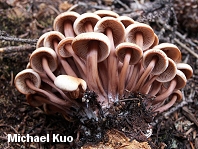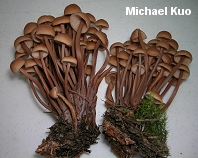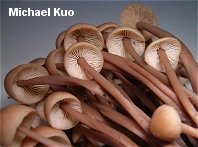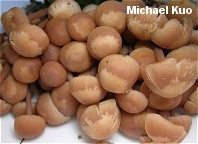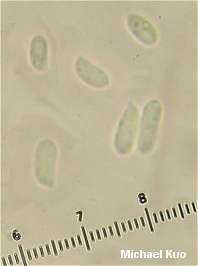| Major Groups > Gilled Mushrooms > Pale-Spored > Collybioid > Connopus acervatus |

|
Connopus acervatus [ Basidiomycetes > Agaricales > Tricholomataceae > Connopus . . . ] by Michael Kuo Defining features for this distinctive mushroom, which was known as "Gymnopus acervatus" or "Collybia acervata" until very recently, include the densely clustered growth on the wood of conifers; the convex (not conical) reddish brown caps that fade to pinkish buff; and the reddish to reddish brown stem that is bald except for the slightly fuzzy base. Older specimens demonstrate a marked contrast between the pale caps and the reddish stems. A recent study by Hughes and collaborators (2010) used two genes (ITS and LSU) to examine many collybioid mushrooms; collections of "Gymnopus acervatus" grouped separately from other species of Gymnopus and from species of Rhodocollybia. Thus, the authors proposed a new genus name, Connopus, to accommodate Gymnopus acervatus. The authors' data found potential support for the idea that the western North American version of Connopus acervatus "might be a distinct species" (p. 1476). Collybia acervata and Gymnopus acervatus are synonyms. Thanks to the Sam Mitchel Herbarium of Fungi at the Denver Botanic Gardens for facilitating my study of the Connopus acervatus collection cited and described below. Description: Ecology: Saprobic; growing in dense clusters on conifer stumps (and sometimes from buried conifer wood, appearing terrestrial); summer and fall, or in winter in Texas and California; fairly widely distributed in North America but apparently absent or rare in southwestern and southeastern areas. Cap: 1-5 cm; convex, becoming planoconvex; smooth; reddish brown and moist when young and fresh, but soon fading to brownish or pinkish buff (often passing through a two-toned stage). Gills: Attached to the stem broadly or narrowly; close or crowded; whitish when young, developing pink tones. Stem: 2-12 cm long; up to about 6 mm thick; more or less equal; dry; hollow; smooth except for whitish fuzz near the base; reddish brown to purplish brown; not fading as quickly as the cap. Flesh: Thin; whitish. Odor and Taste: Odor not distinctive; taste mild or bitter. Spore Print: White. Microscopic Features: Spores: 5.5-7 x 2.5-3 µ; smooth; elliptical or nearly cylindric; inamyloid. Pleurocystidia absent. Cheilocystidia up to about 40 µ long; variously shaped; often with protrusions or lobes--or, in western North American collections, more or less cylindric with subclavate or merely rounded apices. Pileipellis a tangle of cylindric, branching (but not diverticulate or coralloid) hyphae 2-5 µ wide. REFERENCES: (Fries, 1821) K. W. Hughes, Mather & R. H. Petersen, 2010. (Saccardo, 1887; Kauffman, 1918; Smith, Smith & Weber, 1979; Arora, 1986; Phillips, 1991/2005; Lincoff, 1992; Barron, 1999; Halling, 2004; McNeil, 2006; Miller & Miller, 2006; Trudell & Ammirati, 2009; Hughes et al., 2010.) Herb. DBG 18199. This site contains no information about the edibility or toxicity of mushrooms. |
© MushroomExpert.Com |
|
Cite this page as: Kuo, M. (2013, January). Connopus acervatus. Retrieved from the MushroomExpert.Com Web site: http://www.mushroomexpert.com/connopus_acervatus.html |
